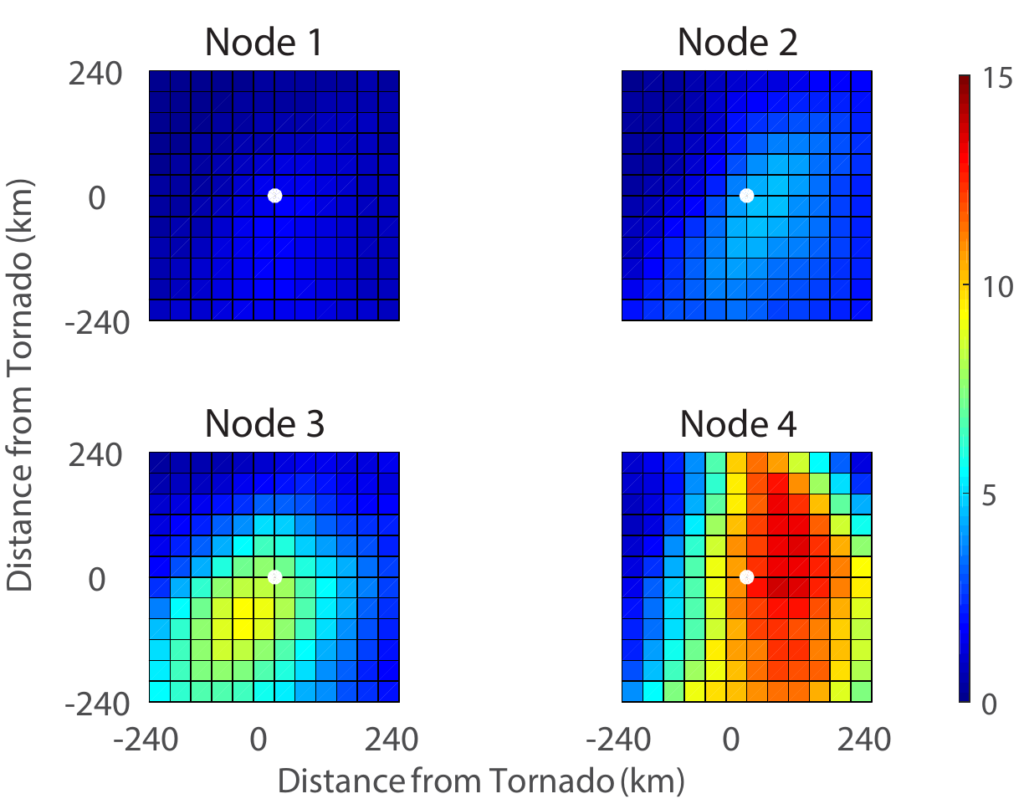29 October 2019
Things We Know About Deadly Tornadoes
Posted by Dan Satterfield
I saw this post on Twitter last week and ask one of the co-authors if they would write a plain-language summary to post here. You can click on the post if you have access to the AMS Journals but below is a summary of what the authors discovered. I have not met Alex, but I do know when Harold Brooks says something about tornadoes, meteorologists ALL listen. Congrats to both for some valuable research, and it should be given more widespread publicity than just among my fellow meteorologists.
Thank you Alex for taking the time to write it up for me!
Guest Post Alexandra K. Anderson-Frey Cooperative Institute for Mesoscale Meteorological Studies, The University of Oklahoma and NOAA/OAR National Severe Storms Laboratory, Norman, Oklahoma:
Here are some of the main points from the paper:
We looked at 16,232 tornado events in the continental U.S., which occurred between 2003 and 2017.
One of the big pushes of this work is to get people talking about the differences between what we know about deadly tornadoes (that is, all tornadoes that resulted in at least one death) and what we know about tornado deaths (that is, the total number of deaths from tornadoes). As an example, EF4 and EF5 tornadoes make up only 0.8% of all tornadoes… but they’re responsible for nearly a quarter (22.8%) of all deadly tornadoes, and over half (50.8%) of tornado deaths! On the flip side, EF0 and EF1 tornadoes make up 86% of all tornadoes, but only 11.9% of deadly tornadoes, and only 3.9% of tornado deaths.
If a particularly intense tornado causes deaths, chances are good that it causes a lot of them (the mean [median] deadly EF5 tornado results in 29 [14] deaths). On the other hand, a weaker tornado that causes deaths likely just resulted in one fatality (the mean and median deadly EF0 tornado both result in just 1 death).

That said, we’re generally warning the right tornadoes: 87% of deadly tornadoes had a warning out ahead of time, and nearly 95% of tornado deaths occurred within an active warning. While this might at first glance seem like a “wait, what?” moment, we also note that the environmental scenarios in which tornado warning skill is highest also tend to be the scenarios conducive to the more dangerous, and hence deadliest, tornadoes. The environments in which deadly tornadoes are well-warned are also the environments in which non-deadly tornadoes are well-warned, but those environments happen to be more likely to produce high-EF-scale, more-likely-to-be-deadly tornadoes.

In this paper, we also made use of a method called Self-Organizing Maps (SOM), which basically takes as input a large stack of weather maps (in this case, maps of the Significant Tornado Parameter, where values greater than one generally indicate environments that could support tornadoes rated EF2+). For its output, the SOM will cluster all these events together into “typical” environments it finds that are statistically distinct from each other. This is especially handy because it means we can look at the two-dimensional shapes of the data and compare them directly to the maps that forecasters actually use to decide whether or not to issue a warning.
We fed in several thousand deadly tornado environments, and this is what the SOM determined were the four most typical deadly tornado setups:

The white dot at the center of each of these plots is the location of the tornado, and warmer colors indicate higher values of the Significant Tornado Parameter, and therefore more “favorable” environments. So, for instance, Node 4 is an environment in which the most favorable environments for tornadoes are located to the east of where the tornado ended up forming; Node 3 has the most favorable environments to the southwest of the tornado.
What this then lets us do is calculate statistics for each cluster. Which seasons do each of these scenarios tend to happen in? We can figure that out!

Those much more intense scenarios (Nodes 3 and 4)? Nearly always happen in the springtime, whereas deadly tornadoes with more marginal and difficult-to-forecast environments also tend to happen in the winter, fall, and summer months.
We can also look at a comparison between the most intense identified environment for deadly tornadoes… and the most intense identified environment for non-deadly tornadoes:

That’s deadly tornadoes on the left versus non-deadly tornadoes on the right. Note that the deadly tornadoes generally have this much more asymmetric shape, compared to the near-circle we see with non-deadly tornadoes; a lot of the more deadly tornado outbreaks occur along linear features like a dryline rather than in isolated patches of favorable environments.
Thanks again for your interest in this paper!
—
Alexandra Anderson-Frey
Assistant Professor
Department of Atmospheric Sciences
University of Washington
ATG 524
[email protected]



 Dan Satterfield has worked as an on air meteorologist for 32 years in Oklahoma, Florida and Alabama. Forecasting weather is Dan's job, but all of Earth Science is his passion. This journal is where Dan writes about things he has too little time for on air. Dan blogs about peer-reviewed Earth science for Junior High level audiences and up.
Dan Satterfield has worked as an on air meteorologist for 32 years in Oklahoma, Florida and Alabama. Forecasting weather is Dan's job, but all of Earth Science is his passion. This journal is where Dan writes about things he has too little time for on air. Dan blogs about peer-reviewed Earth science for Junior High level audiences and up.